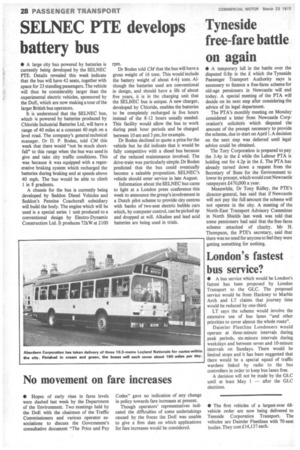SELNEC PTE develops battery bus
Page 30

If you've noticed an error in this article please click here to report it so we can fix it.
• A large city bus powered by batteries is currently being developed by the SELNEC PTE. Details revealed this week indicate that the bus will have 42 seats, together with space for 23 standing passengers. The vehicle will thus be considerably larger than the experimental electric vehicles, sponsored by the DoE, which are now making a tour of the larger British bus operators.
It is understood that the SELNEC bus, which is powered by batteries produced by Chloride Industrial Batteries Ltd, will have a range of 40 miles at a constant 40 mph on a level road. The company's general technical manager, Dr D. P. Boden, told CM this week that there would "not be much shortfall" to this range when the bus was used in give and take city traffic conditions. This was because it was equipped with a regenerative braking system which recharged the batteries during braking and at speeds above 40 mph. The bus would be able to climb 1 in 8 gradients.
A chassis for the bus is currently being developed by Seddon Diesel Vehicles and Seddon's Pennine Coachcraft subsidiary will build the body. The engine which will be used is a special series 1 unit produced to a conventional design by Electro-Dynamic Construction Ltd. It produces 72kW at 2100 rpm.
Dr Boden told CM that the bus will have a gross weight of 16 tons. This would include the battery weight of about 4-4+ tons. Although the batteries used are conventional in design, and should have a life of about five years, it is in the charging unit that the SELNEC bus is unique. A new charger, developed by Chloride, enables the batteries to be completely recharged in five hours instead of the 8-12 hours usually needed. This facility would allow the bus to work during peak hour periods and be charged between 10 am and 3 pm, for example.
Dr Roden declined to quote a price for the vehicle but he did indicate that it would be fully competitive with a diesel bus because of the reduced maintenance involved. The drive-train was particularly simple. Dr Boden predicted that the bus could eventually become a saleable proposition. SELNEC's vehicle should enter service in late August.
Information about the SELNEC bus came to light at a London press conference this week to announce the group's involvement in a Dutch pilot scheme to provide city centres with banks of two-seat electric bubble cars which, by computer control, can be picked up and dropped at will. Alkaline and lead acid batteries are being used in trials.












































































































